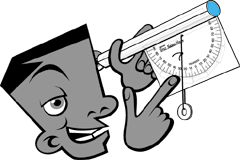Mikayla's Digital Portfolio

Somewhat Serious Surveying
In this task, we were looking to find the height of a slide, where we could not measure the distance to the slide from any point, nor the actual height of the slide. We had to find the height of this slide from beyond a fence, which was an unknown distance from the slide. This mimics when British surveyors tried to find the height of mount everest when they were not allowed withing Nepal.
This is how we solved the problem. We picked two known points and measured the distance between them.
This distance was 28 ft. Then we guestimated the first angle (E) at 110 degrees. Then we guestimated the second angle (D) at 20 degrees. We guestimated by laying a piece of sting along the line of sight and measuring the angle. Our triangle then looked like this, with "B" being the point where the slide is.
We then guestimated the upards angle of the slide. Our guestimation was fairly accurate, as one of my group members layed on her stomach and measured with our improvised inclinometer. This inclinometer was made out of a protractor with a piece of string tied to the middle of it. Below is a rough representation of what we looked like while measuring the angle.
We then had a second triangle that looked like this, where angle "C" is a right angle:
Then we evaluated our original tringle to find the length of what would be side AC on our second triagle. We did this by splitting the first triangle into a right triangle:
Now, I needed to find the lengths of all the sides of traingel ACD. First I established what I knew in terms of angles. I knew that angle DCA was 90 degrees, and I also knew that angle CAD was 20 degrees because we measured it. I also knew that side AC was 28 feet, because that was one of our original measurements. I found the Cosine of angle A (20 degrees) which was 29.016. Then I found the sine of A, which was 6.202. I now know all the sides of the triangle. CD is 6.202, AC is 28, and AD is 29.016.
To find the measurement of triangle CDB, I wrote down and identified what I knew: angle B is 20 degrees (from original measurments), angle C is 20 degrees (110-90), and angle D must then equal 140. Side CD is 6.202 and all I needed then was the side DB. To find that, I split CBD into two right triangles. I found that this created a 20, 90, 70 triangle. I then found the length of each side using sine and cosine. I found that DB + AD equaled 36.61.
Then I dealt with the next triangle formed by the verticle angle.
Here, I knew that angle C was 90, and we had estimated angle A to be 20 degrees. I also knew that AC is 6.202. That meant that I could find the measurement of side BC (the height) by finding the tangent of 20. That equaled 13.87. The height of the slide is 13.87 feet.
Overall, this task was exceptionally challenging. When I first looked at the problem, I had no idea whatsoever how to solve it. In fact, my group was the last one to understand the concepts needed to even find the measurements. However, it turned out that we had to use two very important Habits of a Mathematician: start small and be patient/persistant. We needed to find a measurement that we would know in order to solve for all the measurements that we did not know. We started small by breaking the problem up into two triangles and solving for what we knew. We also needed to remain patient and persistent, especially because this problme required that we used the information we knew previously in new ways.





